Travel Diary 3: The Galápagos
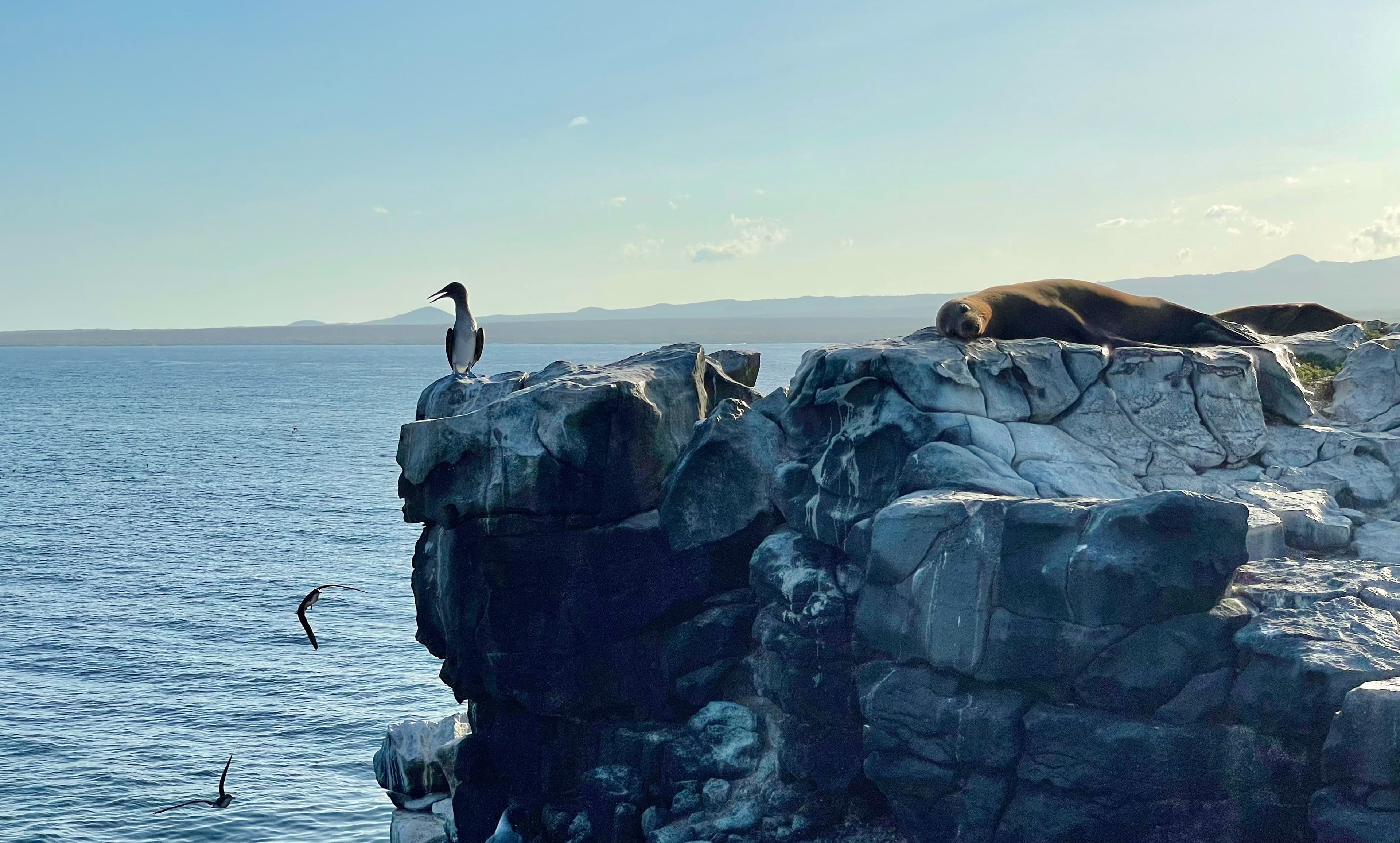
Darwin
If you've been following along with this blog so far, you may have already noticed I talk a lot about nature. Trees, rocks, waves, animals—these are the things I notice around me, infusing my observations with a certain rootedness. I'm always curious about the non-human denizens of each place I visit. What brought them there? How long have they been around? How are they changing?
Last month, I came to Ecuador mainly just to visit an old friend, but I tacked on a trip to the Galápagos Islands afterwards. It just seemed foolish not to swing by.
Everybody thinks of the Galápagos as the site of Darwin's discovery of evolution. Towns on the islands love to play this up, plastering cute illustrations of a friendly grandpa Darwin on chocolate bars, cafés, and other touristy products.
Underneath this kitsch is the reality of what makes the Galápagos special. They're a fascinating reservoir of life from many different regions of the world. Land animals, marine life, and birds mix in unexpected ways here, borne by a confluence of three ocean currents. At the same time, the islands are relatively inhospitable. Every species is locked in a battle for survival, seeking an ecological niche that will allow it to thrive.
That's why Darwin found such rich material to study as he formulated his Origin of Species, and that's also why the Galápagos uniquely enable the sorts of natural interactions I'm drawn to. The islands are bursting with life, above and below the surface of the sea, and most of the animals are content to coexist around humans, unfazed by our presence. It's easy to get close.
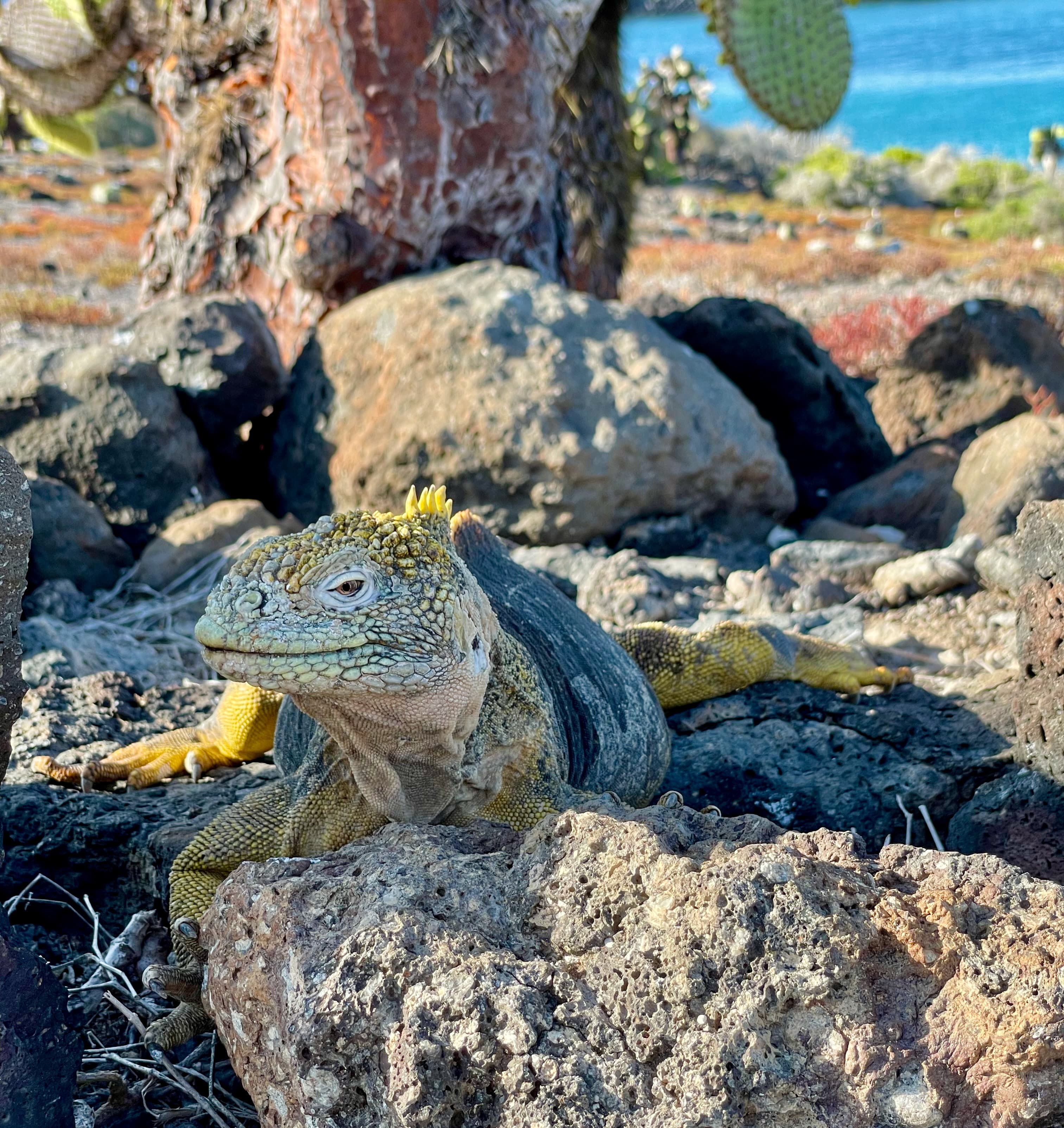
Darwin had always been inexplicably drawn towards examining and interacting with the natural world. While studying theology at Cambridge, Darwin blew off his prescribed lectures to attend botanical lectures instead. Darwin “had become fascinated by beetles and went on long walks, lifting stones and logs, stuffing his bags with his entomological treasures.” [1]
His excitement built to a fever pitch, and despite the discouragement of his father, who said a voyage across the world was a “useless undertaking,” Darwin managed to find a spot for himself on the Beagle.
While on the five-year voyage, Darwin was thrilled to collect and study all manner of natural specimens throughout South America, ranging from rocks and trees to insects, worms, and birds. His excitement rubbed off on the crew, who started helping him collect specimens as well.
Although Darwin found the Galápagos Islands fascinating, it was only much later, after returning to England, that he would begin to realize the gravity of his observations there.
The memories that stick
When you're traveling, it's often not obvious which experiences will matter later. What seems initially striking may be forgotten; what seems trivial may eventually become significant or memorable.
OK, let's do it—here's the most spectacular thing I saw in the Galápagos.
That's a school of hammerhead sharks I saw while scuba diving at Seymour Channel, a common conduit for their species as they migrate through the area at this time of year.
The reality, though, is that with the naked eye, I mostly saw a school of hammer-shaped smudges in the distance. My dive master's GoPro captured these sharks with much greater detail than I could've ever seen.
We were lucky to see those sharks, but as we emerged from the dive, we got even luckier: a school of dolphins decided to circle us as we surfaced, swimming dizzyingly close while emitting their characteristic squeals, which were audible underwater.
These experiences were stunning and memorable, no doubt. But as I've reflected on my visit, I've found that the memories that have stuck with me the most have been much more mundane and difficult to capture. I'll recount two of them below.
The turtle
By the end of my time in the Galápagos, when someone pointed out a sea turtle, I practically rolled my eyes—I'd seen dozens of them by this point, and they just weren't all that special to me anymore. Earlier, though, I had interacted with a sea turtle in an unexpected way that stuck with me.
I was snorkeling by the shore of Floreana Island, where the waters were crystal-clear and teeming with life. A few enormous turtles were among us, their shells about the size of my torso. At one point, I found myself suspended alone directly above a turtle, swept around by the same tides that it was riding.
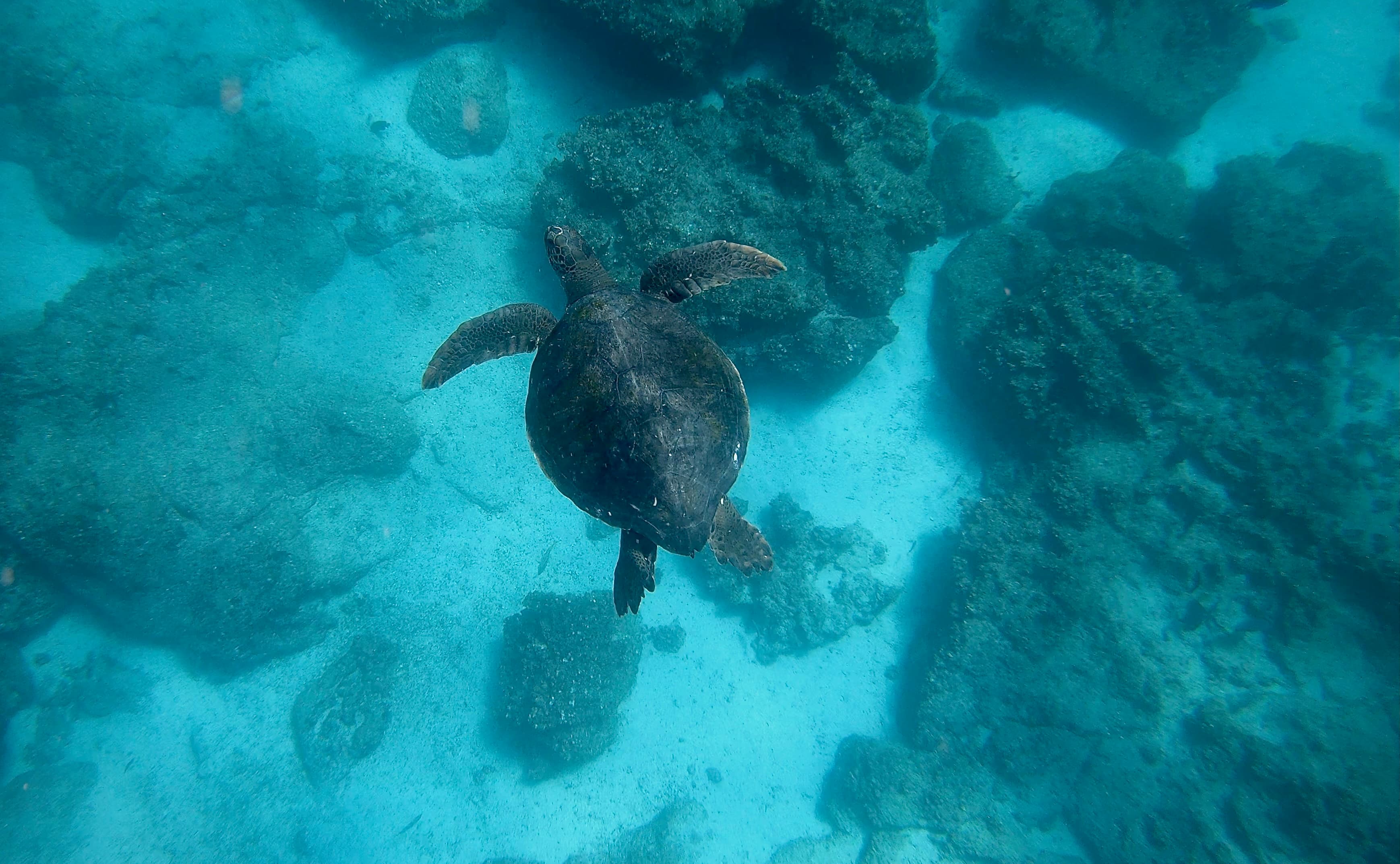
The turtle wasn't doing much. As the tide swelled and washed it towards shore, it swam a little and munched on aquatic plants growing on the reef, scraping against rocks with its beak. As the tide ebbed, the turtle simply let itself be carried away from shore.
I let myself float above the turtle, watching as it fed on those rock-bound plants. It felt dream-like to drift back and forth, surrendering to the tidal forces that defined this creature's life. The jolt of a current swept me towards the reef, the turtle nibbled, and then the outbound current swept me back out, again and again and again.
This is life in the water: letting the tides and currents do their work and figuring out how to use them to your advantage. Although I'd been reading about aquatic life during my time in the Galápagos, this small experience made me feel an embodied connection with the rhythms of this sea creature. I can still close my eyes and remember that feeling.
The sharks
I saw dozens, if not hundreds, of sharks during my time in the Galápagos. The vast majority of them were whitetip reef sharks, which are small and unassuming—cute, even.
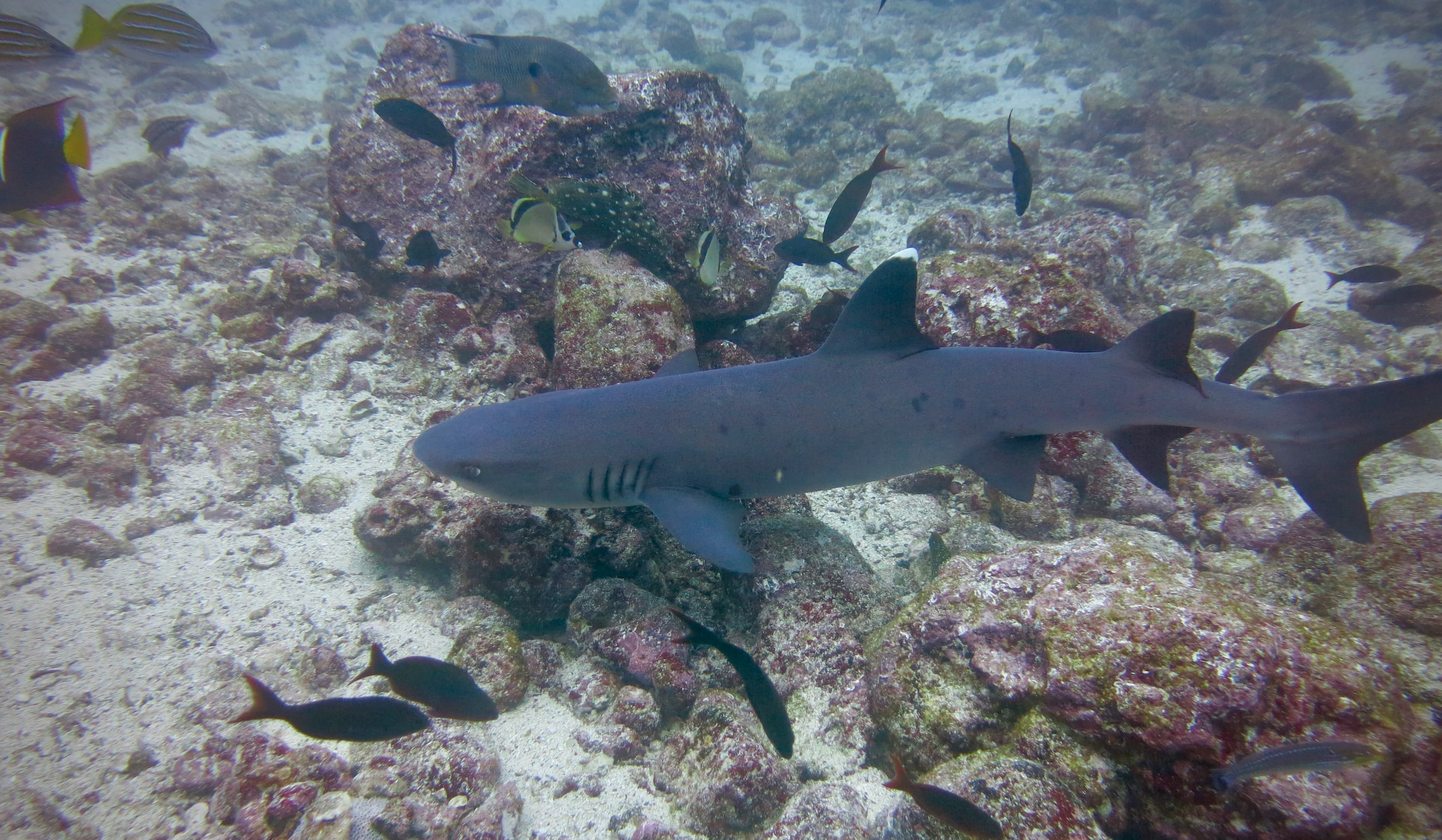
But there are other kinds around, too. The Galápagos shark is a large, scarier-looking creature that commonly grows to more than 9 feet. They typically don't attack humans, though the Wikipedia section on human interactions suggests that a few attacks have been reported over the years.
During another snorkeling session, I was swimming far away from shore, attempting to spot larger marine life such as hammerhead sharks at the bottom of the sea. I was all alone when I spotted the faint outline of a large Galápagos shark circling in the water, about 30 or 40 feet away.
I was struck by a wave of fear. I didn't know much about these sharks at that moment, and despite having seen many small sharks during my aquatic excursions so far, the size and agility of this shark scared me. I swam away as quickly as I could.
The next day, I was snorkeling in clear, shallow water near a beach full of sea lions. At one point, I turned to my left and saw another 9-foot Galápagos shark only about 15 or 20 feet away. At this proximity, the shark looked terrifying. I could tell it could close the distance with me in a matter of seconds, and there wasn't much I could do if it chose to.
By now, though, I knew these sharks didn't interact with humans much, and the prospect of getting close to this animal was exciting. Empowered by the adrenaline rush, I swam towards the shark this time. But before I knew it, it had disappeared.
These shark encounters were very different from drifting above the turtle. Rather than feeling a sense of harmony with another being, I felt a repulsion, a primordial fear. The connection I felt was not with another creature, but with the animal within myself—the primitive feeling that emerges when you encounter a predator that could easily outpace you and rip you apart if it chose.
Some people seek out that fear and discomfort just to feel an adrenaline rush, and I have a bit of this thrill-seeker in me too. I believe what underlies this strange attraction is a deeper insight: experiencing an animal fear helps contextualize other fears and worries in your life.
Modern life is full of theoretical fears. Maybe you'll lose your job because of an impending recession, or because you'll get replaced by an AI. Maybe a societal or political change will cause harm to people you care about.
Connecting with what fear really is—the kind that grabs you in an instant, makes you fight or flee—makes these theoretical fears not so scary, at least for me. Maybe we should all come face-to-face with sharks a little more often.
Tourism and nature
Another day, I watched with awe as a solitary American flamingo preened and flapped its wings on the shore as crystalline waves broke on the beach—an untainted experience of pristine nature.
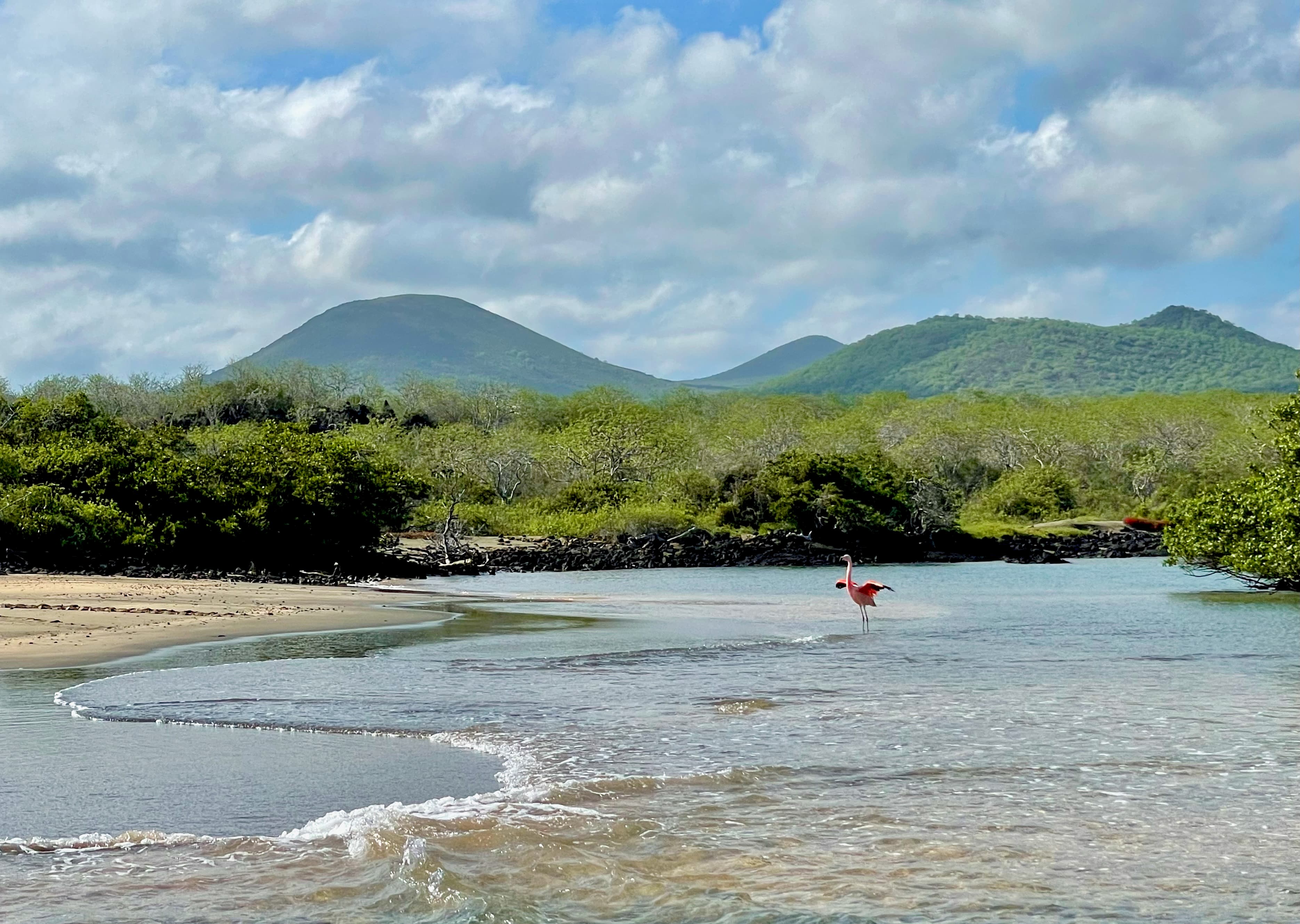
…except, the reality of my experience was more like this.
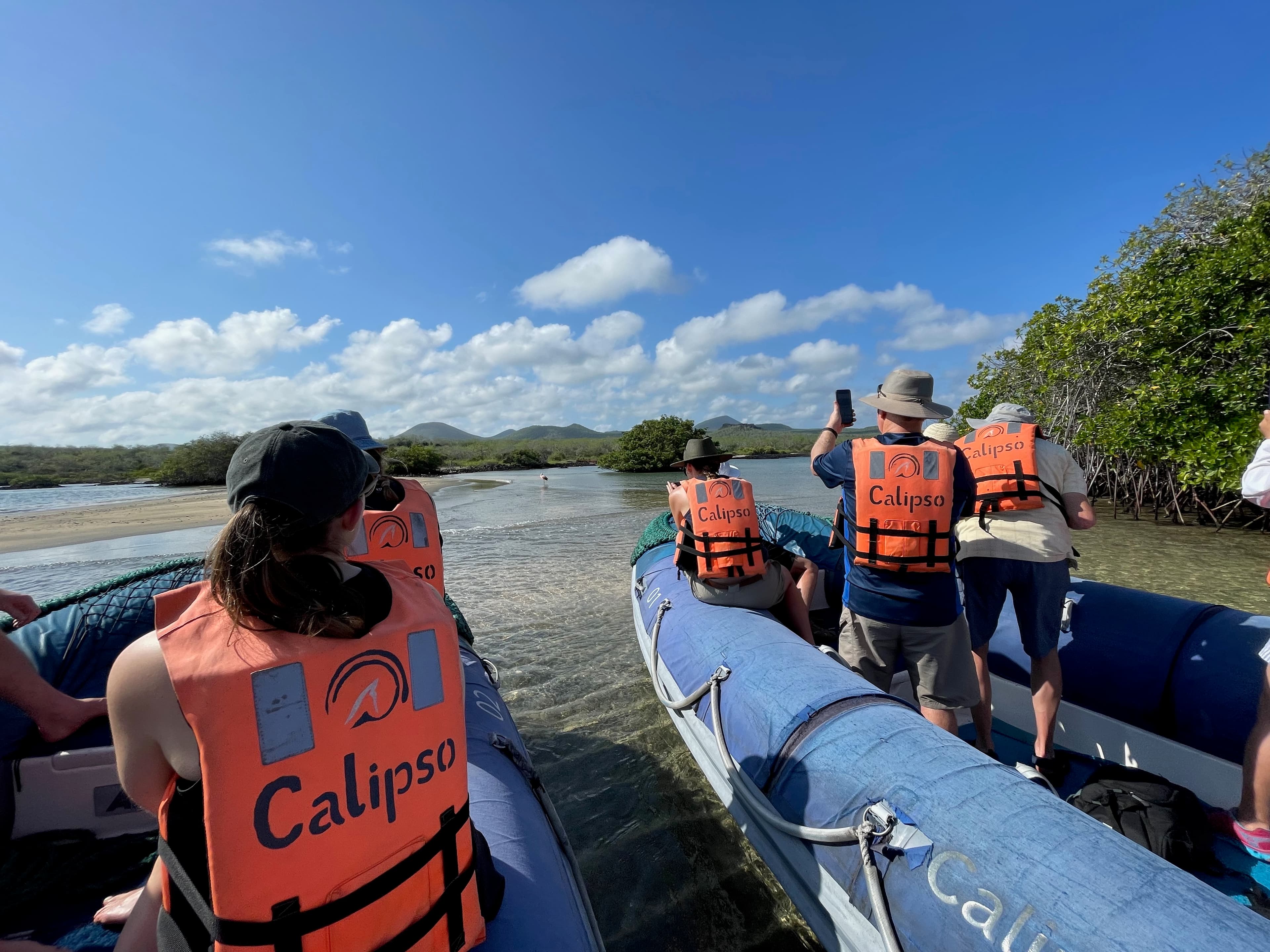
This flamingo was walking around the beach in a calm bay on Floreana Island. That day, five cruise ships docked in this bay; two small boats emerged from each cruise ship; and six people were on each boat. That means almost 100 people came by to see this flamingo that day.
Don't get me wrong. I was just another person in one of these bright-orange life vests taking photos like the rest. I'm not trying to be a tourist complaining that tourists are ruining everything.
But there is something lost when interactions with wildlife are mediated through tour groups and camera lenses. I think it's no coincidence that the memories that have stuck with me most happened when I was floating in the water all alone, without any devices on me (all the underwater images in this post were taken by others and shared with me afterwards).
Each distraction, whether it's other people, a phone, a camera, or even a tour guide, adds separation between you and your subject, like layers of protective glass. Though sometimes these layers are necessary, I think even mundane experiences can glimmer with significance when those layers are peeled away.
Making contact
My time in the Galápagos, oddly enough, reminded me of a gorilla I met a few years ago.
In March 2021, after a year of pandemic lockdowns and the misery of that year's lonely winter, I took a week off work just to get a break from everything. I stuck around New York. Most of my friends had left the city, so I didn't really have anybody to make vacation plans with, and long-distance travel was impossible back then anyway.
I drove upstate to hike around Breakneck Ridge in the middle of the week. On my way, I stopped by the Bronx Zoo, which was nearly empty on a Tuesday in early spring. I saw a lot of things there—exotic birds, two lonely male lions, and much more—but what I remember most is the gorilla.
I walked into the deserted viewing room and was reading the plaques about her species when the gorilla walked out, casually waving as if I'd been her neighbor for decades. Jolted by her entrance, I looked through the plaques to identify which one she was: the matriarch.
She plopped down and looked around bored for a second, then pointedly fixed her gaze on me. I was mesmerized. Because of her humanoid features and the depth of her intelligence, it really felt like I was just looking at a person.
But unlike actual people, she seemed to feel no urge to break eye contact. She had no trepidation about just gazing into my eyes, continuously and powerfully. She had nowhere else to look, nowhere else to be, no notifications to check, no evening plans, nothing to prove.
I felt viscerally, painfully seen. I was tempted to flinch and look away. But living alone through the pandemic for over a year, spending most days every week without any meaningful human interaction, I felt parched to just interact with another living thing. I drank in the gorilla's attention and interest, surprised at how badly I needed it.
Eventually, she looked away, tapping her wrist to indicate it was feeding time. I stared at the ground as I ambled away, a bit shaken by the interaction.
If there's one thing I learned from sticking around New York City during the pandemic, it's that in times of struggle and loneliness, a relationship with nature is what helps me get through things. The pandemic winter of 2021 marked a low point. Stuck indoors because of the bitter cold, I couldn't even go for a stroll to look at a bird or something.
I've come to realize that the essence of that gorilla moment is what I usually seek in nature: a momentary, often unexpected connection with some other living being.
In my life, there are constantly moments when I witness something: a lonely, flowering cherry tree; a passing flock of yellow warblers at a lakeside in Pennsylvania; evergreens creaking and scraping at Parque Arví in Medellín; a shark circling in the Galápagos waters. And in an instant, my attention flees the confines of my skull and inhabits the world outside myself. I'm swept away. That experience, for someone cerebral like me, living in what feels like an increasingly cerebral time, is rapturous—a much-needed respite.
The wonderful thing is that I don't need much for this feeling to emerge. Sometimes, a squirrel suffices.
I'm two weeks into my trip to Japan now. The sakura are in full bloom here in Kyoto, starting to shed their petals like rose-pink confetti blown in the crisp spring wind.
Till next time,
Vipul
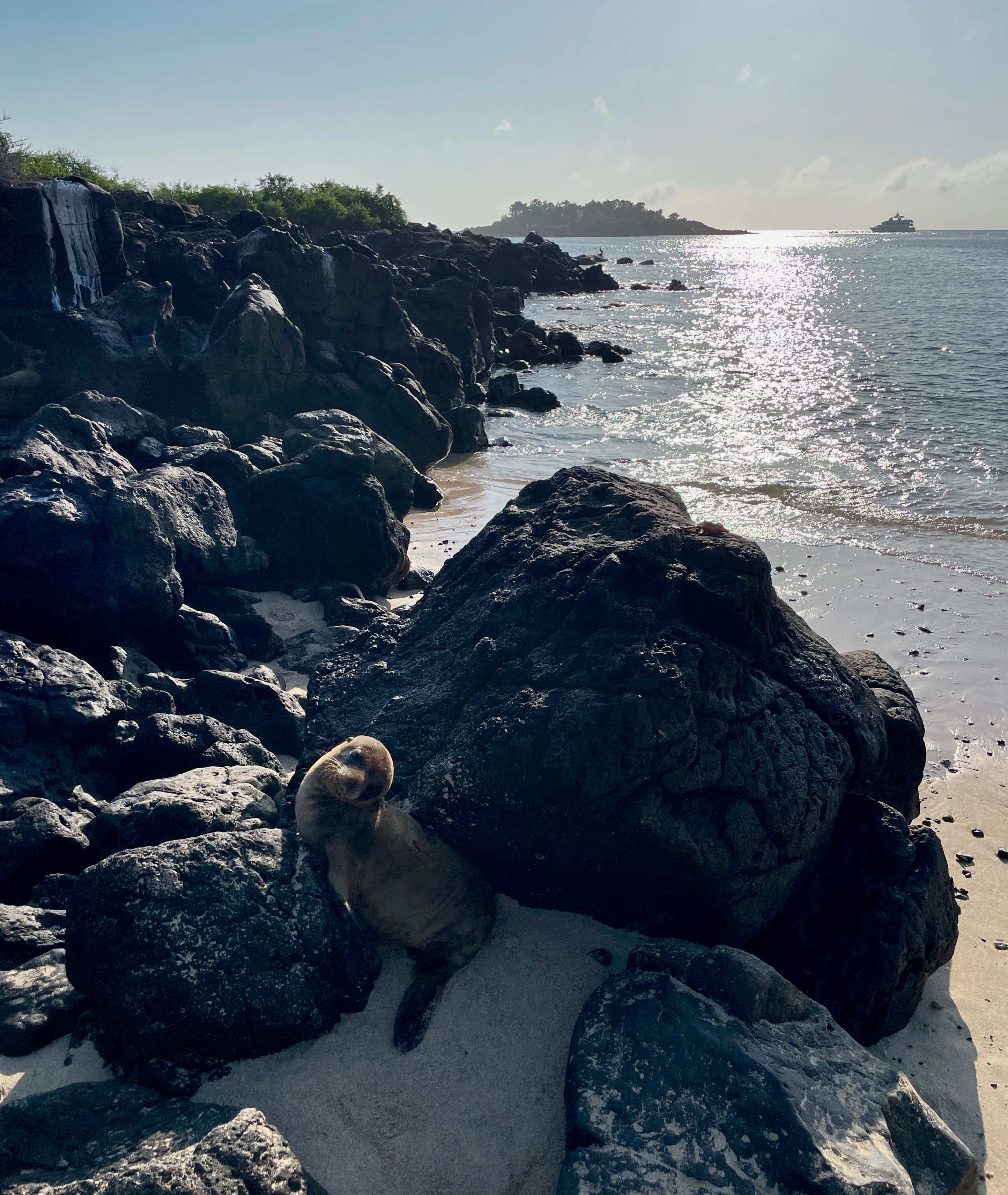
[1] From The Invention of Nature: Alexander von Humboldt's New World by Andrea Wulf